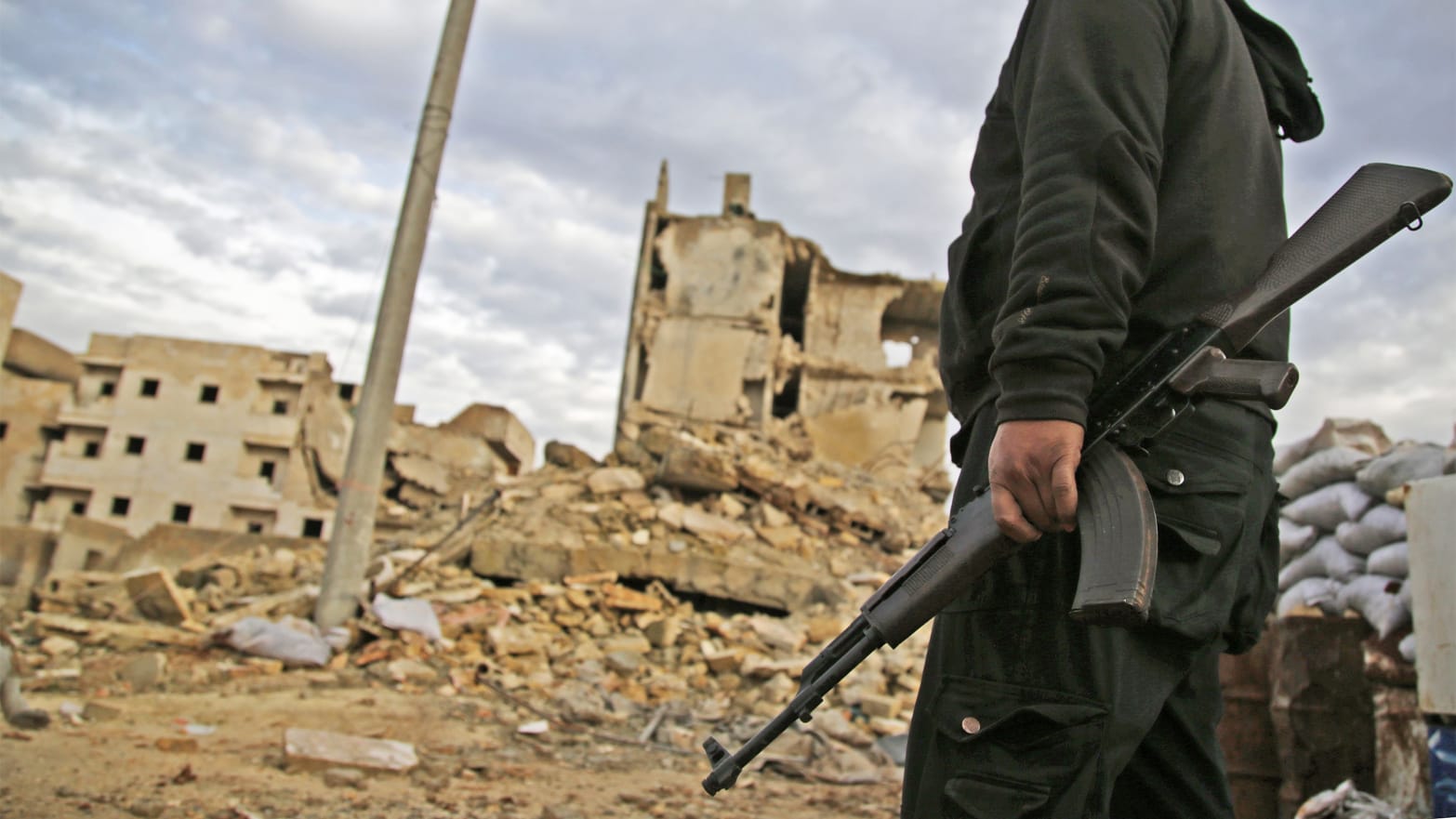Black soot still covers the sidewalk outside of the café where a suicide bomber killed 15 people, including four Americans, in the northern Syrian town of Manbij last week. Inside the now hollowed-out building, charred silver baking trays sit on their side. Several knives are strewn across the floor behind a large oven. Blood stains bits of metal scraps that lie in front of the building.
But the steel skewers that used to twirl bits of chicken and lamb still stand. Local business owners on one of the main drags in the city, who sent pictures of the blast site to The Daily Beast, say they already are trying to restore the café.
“It had the best shawarma in town,” one of them told The Daily Beast in a Skype call earlier this week. To Ahmed, who owns a convenience shop down the street, revitalizing the café is a way of reminding the city that it fought its way out from under the grip of the so-called Islamic State group once and it can do it again. ISIS claimed responsibility for the attack January 16.
“We didn’t have U.S. troops here helping us then,” he said, referring to the ground forces fighting ISIS in pitched battles until they finally took back the city in 2016. “So, I guess if we have to we can fight once more.”
But the reality of U.S. troops leaving Syria is reverberating across the country and not everyone is as defiant as Ahmed. As the Syrian war is set to enter its eighth year, media activists, soldiers and rebel fighters who spoke to The Daily Beast from places like Idlib, Damascus, Al Bab and Manbij, say they fear the conflict is set to enter an entirely new phase—one spurred by President Donald Trump’s decision to withdraw troops.
Now, sources that include top Kurdish and Arab commanders say Syria could experience not only a renewed effort by Israel to escalate tensions with Iranian assets in the country, which appeared to kick off over the weekend, but also reinvigorated operations by emboldened terrorist groups.
When the civil war in Syria broke out in 2011, the Obama administration, hesitant to engage directly President Bashar al-Assad’s military, instead spearheaded two programs to prop up rebel forces. One of those programs helped train rebels at U.S. outposts in Jordan and another—a $1 billion venture headed by the CIA—oversaw the shipment of weapons to other factions. But reports surfaced that some of those weapons had fallen into the hands of extremists and eventually both of those programs folded.
Faced with an increasingly dire humanitarian situation on the borders of Syria and the blatant use of chemical weapons by the Assad regime, the Obama administration in 2014 formed, along with 60 other countries, an international coalition to fight ISIS in the country and provide air support to rebels on the ground. It wasn’t until 2015 that the Obama administration finally decided to send ground forces, mostly special forces, into the country. That group eventually grew to a force of 2,000 which is now backing up the Syrian Democratic Forces—a group of Kurdish and Arab fighters viewed by Turkey as a terrorist organization. Its dominant Kurdish elements are closely tied to the PKK that has been fighting the Turkish government for decades and is recognized internationally as a terrorist organization.
When the U.S. troops leave the northern part of Syria, their allies, the SDF, will be left to handle attacks not only by ISIS and Assad, but also by Turkey. And areas of Syria that have experienced indirect or direct aid from U.S. troops, including air support and ground control, could return to chaos, Kurdish commanders told The Daily Beast.
Because if U.S. troops leave, so too will coalition troops, they say. And if that happens, some predict President Assad will reaffirm his grip on power— perhaps more firmly than at any time since the war started in 2011. (The French government has vowed to stay in Syria).
“U.S. politics in Syria are very confusing lately,” said Mustafa Sejari, a top commander in the Free Syrian Army, another rebel group, which is supported by Ankara. “We hope that the withdrawal will happen in coordination with Turkey. We are afraid that otherwise it may be in best interest of PKK, the Assad regime and its allies like Russia and Iran.”
Russia and Iran are coordinating military offensives in Syria to prop up the Assad regime. Over the weekend, Israel said it fired a series of missiles at Iranian forces stationed near Damascus in an attempt to deal a blow to Assad and the Iranian Quds Force fighters abetting him.
With all the fear over renewed attacks by ISIS, commanders in the FSA and the SDF said they have not forgotten about the need to clamp down on regime forces who continue to imprison political opponents en masse. But fighting the regime has become an afterthought for many of the rebel forces in the northern part of the country, some of whom welcomed Israel’s strike on Iranian targets over the weekend.
No one knows exactly when the Trump administration will begin to move troops out of the country officially. After the announcement in December, the withdrawal seemed imminent, according to sources serving in train-and-assist positions in northeastern Syria.
In the hours after the news broke, U.S. troops were briefed about the president’s decision and told that some would begin to move into bases in western Iraq, others would be re-deployed elsewhere in the Middle East, and some would get to go home.
Since then, though, the timeline for troop withdrawal has become less and less clear.
Secretary of State Mike Pompeo and National Security Adviser John Bolton have both traveled to the region and attempted to assuage allies’ fears that the U.S. was giving up on Syria. Trump administration officials have desperately tried to broker a handshake agreement with Turkey about it not only taking over leading the fight against ISIS, but also refraining from engaging in active violence with the Kurds in the northern part of the country.
Even after the formal announcement, individuals in Idlib and Deir Ezzor, a city in the northeastern region of the country where ISIS is still present, told The Daily Beast they’re not convinced the troops will actually leave
“At first when the news came out, we really didn’t believe it,” said Raed al-Saleh, the head of the White Helmets, after the White House’s announcement. The White Helmets is a volunteer organization which attempts to save the lives of those trapped under the rubble from airstrikes “I still think that the U.S. withdrawal from Syria is not true. They talked at the time of leaving but now they’ve stopped talking about it.”
Last week U.S. Senator Lindsey Graham traveled to meet with Turkish officials, including President Recep Tayyip Erdogan, about the timeline for pulling back U.S. troops.
“I can understand the desire to withdraw, but withdrawal without a plan is chaos,” Graham said during a news briefing in Ankara last week. “It would be Iraq on steroids,” he said, referring to the possibility that ISIS would regain significant territory.
That is the fear that is taking hold of the people of Syria. And nowhere is that fear more present than in places like Deir Ezzor where SDF forces are still fighting for liberation from the terrorist group.
“I lost my friend the other day on the battlefield,” said one rebel commander who leads Kurdish forces against ISIS in the region. “We are still fighting there every day. No one ever hears about our fighting in the U.S. But ISIS is still killing us.”
And back in Manbij, the fear of ISIS returning seems increasingly like reality. Kurdish security forces are furiously carrying out a campaign to sniff out terrorist sleeper cells that emerged over the past year.
“All shops were closed immediately after the bombing because of the fear of another explosion,” Ahmed Mohammed, a media and human rights activist from Manbij, told The Daily Beast in the hours after the bombing. “The whole population is in a state of terror, especially [since] the explosion took place in a densely populated residential area.”
U.S. troops, who often stopped at the now bombed-out café to pick up a box of shawarma and some soda, helped the Kurds patrol the city and maintain the peace. Their mere presence was something that had calmed even top Kurdish commanders in Manbij who spoke to The Daily Beast on the condition of anonymity so they could speak publicly about the security situation not only in their city but across the Kurdish-held areas of Syria.
One commander said that keeping the peace has become an increasingly difficult task in recent weeks. Several smaller bombs detonated, injuring several local Kurdish fighters and civilians. And now that President Trump has announced the withdrawal of troops, the commander said his team is considering relying on Syrian military forces to help restore order.
Last month, Kurdish fighters made a formal overture to President Assad in an attempt to enlist help—an extraordinary request that would have been viewed by many in Syria as almost sacrilegious just a year ago.
But the tide is turning now, another Kurdish commander from Manbij said. American troops are leaving and the Kurds cannot hold the territory on their own. One of the reasons? ISIS is not defeated, the commander said.
“We still have groups of men who have escaped from other parts of the country where they once lived and operated with ISIS and are coming back here,” the commander said. “They’re still taking orders from the leaders of the group but are hiding among us.”
The videos from the bombing of the café on Jan. 16 make that point about the present, and it is hard to watch them without seeing, as well, a grim omen of the future.
Pictures and video messages sent to The Daily Beast show images of the explosion. On a busy street, men, women and children stand outside the bustling shop before a burst of light blows out from the left side of the screen. A man and woman collapse, purportedly from the sheer force of the blast, and a small boy is seen running away. Other videos show U.S. servicemen rushing colleagues on stretchers to helicopters on standby in a local soccer field. The men hop into the chopper, sliding the stretchers on with them, and then, the propellers spin in the dusty wind and the Americans disappear into the air.

